Communication and Diversity: Analysis of a Healthcare Scenario at UTS
VerifiedAdded on 2022/11/29
|8
|2023
|422
Essay
AI Summary
This assignment analyzes communication dynamics and cultural safety within a healthcare context, specifically focusing on a scenario involving an Aboriginal patient. It examines the components of communication employed, limitations in communication skills, and potential barriers to effective interaction. The essay delves into the consequences of personal bias on culturally safe and respectful nursing care, emphasizing the importance of adhering to ethical standards and the Nursing and Midwifery Board of Australia's guidelines. The analysis explores alternative communication strategies, such as therapeutic communication techniques, to improve patient outcomes and foster trust and respect. The assignment highlights the impact of predefined thoughts and attitudes on communication, patient care, and recovery, while also addressing the importance of cultural understanding and acceptance to overcome communication barriers. The essay references the 'Closing the Gap' report and underscores the significance of cultural safety and respect for Aboriginal and Torres Strait Islander peoples, advocating for culturally unbiased nursing practices and improved interpersonal relationships to enhance the overall healthcare experience. The conclusion emphasizes the critical role of communication in meeting patient needs, advocating for cultural sensitivity, and providing culturally safe nursing care.
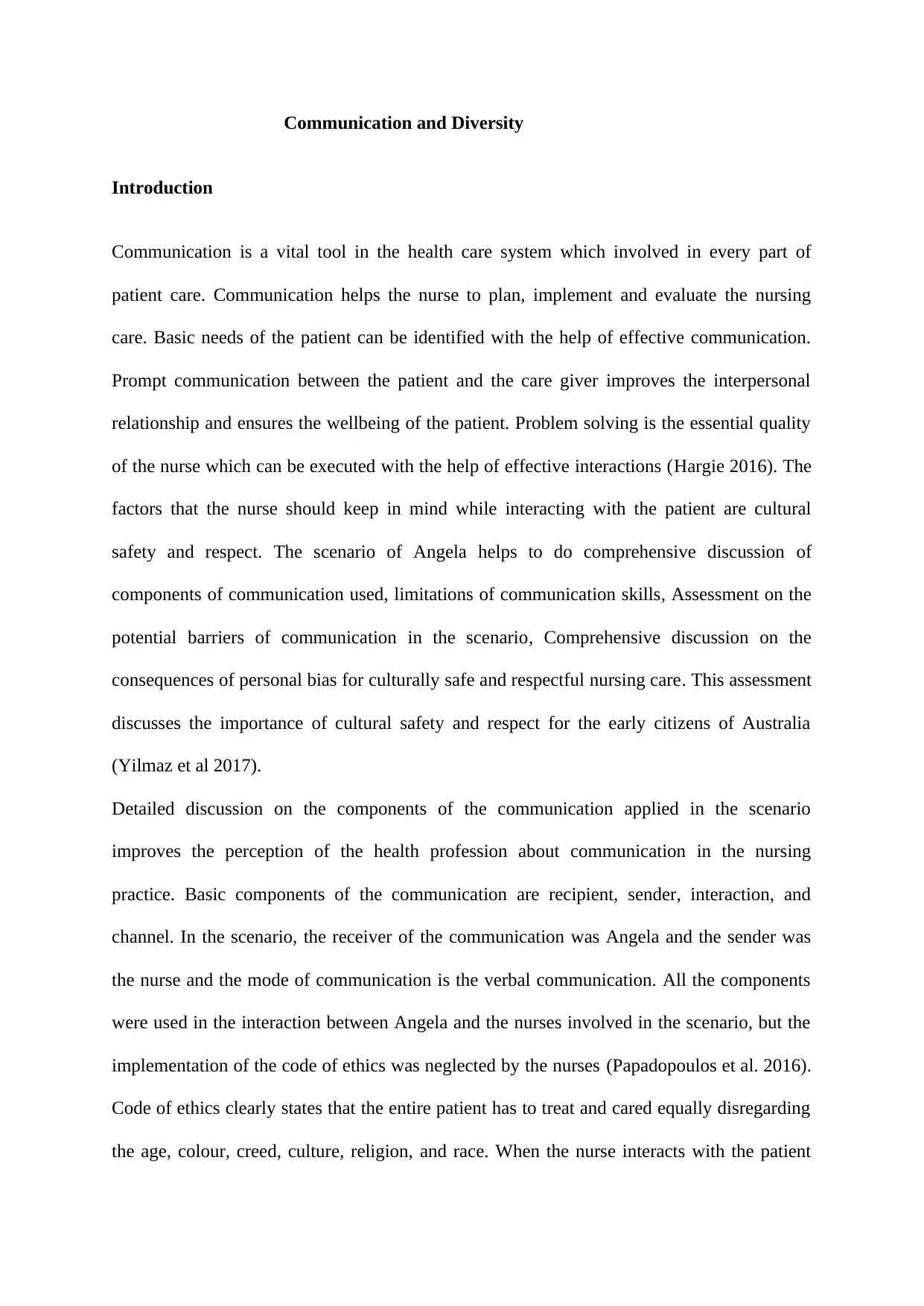
Communication and Diversity
Introduction
Communication is a vital tool in the health care system which involved in every part of
patient care. Communication helps the nurse to plan, implement and evaluate the nursing
care. Basic needs of the patient can be identified with the help of effective communication.
Prompt communication between the patient and the care giver improves the interpersonal
relationship and ensures the wellbeing of the patient. Problem solving is the essential quality
of the nurse which can be executed with the help of effective interactions (Hargie 2016). The
factors that the nurse should keep in mind while interacting with the patient are cultural
safety and respect. The scenario of Angela helps to do comprehensive discussion of
components of communication used, limitations of communication skills, Assessment on the
potential barriers of communication in the scenario, Comprehensive discussion on the
consequences of personal bias for culturally safe and respectful nursing care. This assessment
discusses the importance of cultural safety and respect for the early citizens of Australia
(Yilmaz et al 2017).
Detailed discussion on the components of the communication applied in the scenario
improves the perception of the health profession about communication in the nursing
practice. Basic components of the communication are recipient, sender, interaction, and
channel. In the scenario, the receiver of the communication was Angela and the sender was
the nurse and the mode of communication is the verbal communication. All the components
were used in the interaction between Angela and the nurses involved in the scenario, but the
implementation of the code of ethics was neglected by the nurses (Papadopoulos et al. 2016).
Code of ethics clearly states that the entire patient has to treat and cared equally disregarding
the age, colour, creed, culture, religion, and race. When the nurse interacts with the patient
Introduction
Communication is a vital tool in the health care system which involved in every part of
patient care. Communication helps the nurse to plan, implement and evaluate the nursing
care. Basic needs of the patient can be identified with the help of effective communication.
Prompt communication between the patient and the care giver improves the interpersonal
relationship and ensures the wellbeing of the patient. Problem solving is the essential quality
of the nurse which can be executed with the help of effective interactions (Hargie 2016). The
factors that the nurse should keep in mind while interacting with the patient are cultural
safety and respect. The scenario of Angela helps to do comprehensive discussion of
components of communication used, limitations of communication skills, Assessment on the
potential barriers of communication in the scenario, Comprehensive discussion on the
consequences of personal bias for culturally safe and respectful nursing care. This assessment
discusses the importance of cultural safety and respect for the early citizens of Australia
(Yilmaz et al 2017).
Detailed discussion on the components of the communication applied in the scenario
improves the perception of the health profession about communication in the nursing
practice. Basic components of the communication are recipient, sender, interaction, and
channel. In the scenario, the receiver of the communication was Angela and the sender was
the nurse and the mode of communication is the verbal communication. All the components
were used in the interaction between Angela and the nurses involved in the scenario, but the
implementation of the code of ethics was neglected by the nurses (Papadopoulos et al. 2016).
Code of ethics clearly states that the entire patient has to treat and cared equally disregarding
the age, colour, creed, culture, religion, and race. When the nurse interacts with the patient
Paraphrase This Document
Need a fresh take? Get an instant paraphrase of this document with our AI Paraphraser
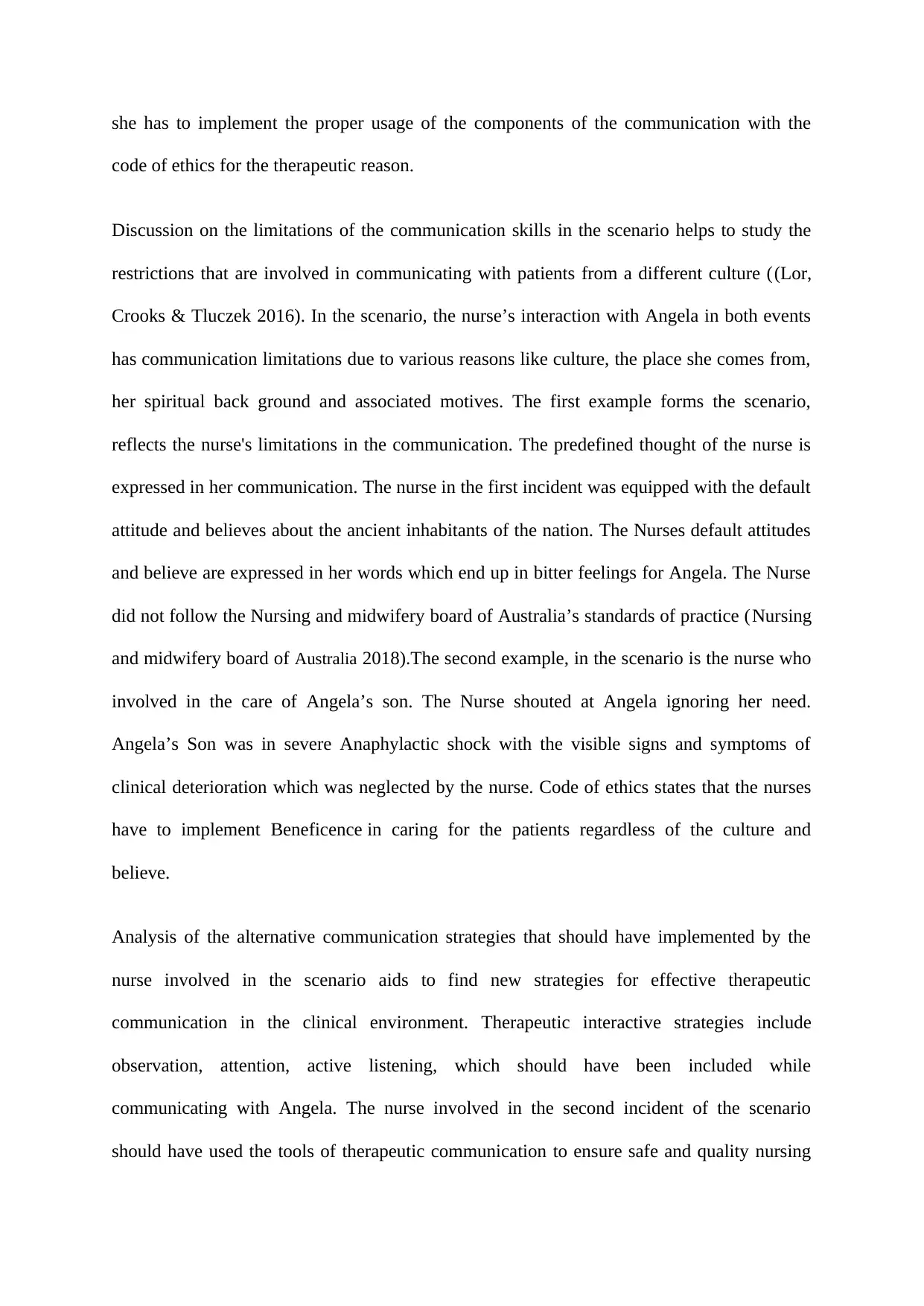
she has to implement the proper usage of the components of the communication with the
code of ethics for the therapeutic reason.
Discussion on the limitations of the communication skills in the scenario helps to study the
restrictions that are involved in communicating with patients from a different culture ((Lor,
Crooks & Tluczek 2016). In the scenario, the nurse’s interaction with Angela in both events
has communication limitations due to various reasons like culture, the place she comes from,
her spiritual back ground and associated motives. The first example forms the scenario,
reflects the nurse's limitations in the communication. The predefined thought of the nurse is
expressed in her communication. The nurse in the first incident was equipped with the default
attitude and believes about the ancient inhabitants of the nation. The Nurses default attitudes
and believe are expressed in her words which end up in bitter feelings for Angela. The Nurse
did not follow the Nursing and midwifery board of Australia’s standards of practice (Nursing
and midwifery board of Australia 2018).The second example, in the scenario is the nurse who
involved in the care of Angela’s son. The Nurse shouted at Angela ignoring her need.
Angela’s Son was in severe Anaphylactic shock with the visible signs and symptoms of
clinical deterioration which was neglected by the nurse. Code of ethics states that the nurses
have to implement Beneficence in caring for the patients regardless of the culture and
believe.
Analysis of the alternative communication strategies that should have implemented by the
nurse involved in the scenario aids to find new strategies for effective therapeutic
communication in the clinical environment. Therapeutic interactive strategies include
observation, attention, active listening, which should have been included while
communicating with Angela. The nurse involved in the second incident of the scenario
should have used the tools of therapeutic communication to ensure safe and quality nursing
code of ethics for the therapeutic reason.
Discussion on the limitations of the communication skills in the scenario helps to study the
restrictions that are involved in communicating with patients from a different culture ((Lor,
Crooks & Tluczek 2016). In the scenario, the nurse’s interaction with Angela in both events
has communication limitations due to various reasons like culture, the place she comes from,
her spiritual back ground and associated motives. The first example forms the scenario,
reflects the nurse's limitations in the communication. The predefined thought of the nurse is
expressed in her communication. The nurse in the first incident was equipped with the default
attitude and believes about the ancient inhabitants of the nation. The Nurses default attitudes
and believe are expressed in her words which end up in bitter feelings for Angela. The Nurse
did not follow the Nursing and midwifery board of Australia’s standards of practice (Nursing
and midwifery board of Australia 2018).The second example, in the scenario is the nurse who
involved in the care of Angela’s son. The Nurse shouted at Angela ignoring her need.
Angela’s Son was in severe Anaphylactic shock with the visible signs and symptoms of
clinical deterioration which was neglected by the nurse. Code of ethics states that the nurses
have to implement Beneficence in caring for the patients regardless of the culture and
believe.
Analysis of the alternative communication strategies that should have implemented by the
nurse involved in the scenario aids to find new strategies for effective therapeutic
communication in the clinical environment. Therapeutic interactive strategies include
observation, attention, active listening, which should have been included while
communicating with Angela. The nurse involved in the second incident of the scenario
should have used the tools of therapeutic communication to ensure safe and quality nursing

care. The nurse’s communication should have reflected respect for the patient’s culture. The
Nurse involved in the second incident should have used the strategies of effective
communication like trust and respect. The nurses should have built trust in her
communication by respecting and accepting the patient’s culture and believes (Milne, Creedy
& West 2016). The nurses should have shown respect for the patient from the culture of the
ancient residents of her beautiful nation. The nurses are caring for people from different
cultures and believe every day, thus the nurses should find new communication strategies that
respect and promotes therapeutic communication.
Discussion on the possible barriers of communication in the scenario helps to improve the
therapeutic communication in the clinical environment. Communication barriers that are
commonly found in the scenario are the predefined thoughts, attitude, and believe. Barriers to
communication are barriers to safe and quality nursing care. The nurses involved in the
scenario had predefined thoughts about the people from specific cultural background which
are express in the communication (Forsgren et al. 2016). Cultural diversity is common in the
health care system, thus the personal believes may significantly affect the communication,
patient care, and recovery. Lack of knowledge about the Nursing and midwifery board of
Australian standards of practice and the code of ethics which clearly instructs on the
importance of valuing the cultures believes, and morals of the people from various
communities. Nursing care involves understanding and respect for the culture of the patient.
People are emotionally attached to their own culture and believe. Therefore, directly and
indirectly hurting the individual's culture and believe injure the patient emotionally. The
nurses have to aware of the communication barriers that are involved in nursing care and
eliminate that with the support of new communication strategies.
Nurse involved in the second incident should have used the strategies of effective
communication like trust and respect. The nurses should have built trust in her
communication by respecting and accepting the patient’s culture and believes (Milne, Creedy
& West 2016). The nurses should have shown respect for the patient from the culture of the
ancient residents of her beautiful nation. The nurses are caring for people from different
cultures and believe every day, thus the nurses should find new communication strategies that
respect and promotes therapeutic communication.
Discussion on the possible barriers of communication in the scenario helps to improve the
therapeutic communication in the clinical environment. Communication barriers that are
commonly found in the scenario are the predefined thoughts, attitude, and believe. Barriers to
communication are barriers to safe and quality nursing care. The nurses involved in the
scenario had predefined thoughts about the people from specific cultural background which
are express in the communication (Forsgren et al. 2016). Cultural diversity is common in the
health care system, thus the personal believes may significantly affect the communication,
patient care, and recovery. Lack of knowledge about the Nursing and midwifery board of
Australian standards of practice and the code of ethics which clearly instructs on the
importance of valuing the cultures believes, and morals of the people from various
communities. Nursing care involves understanding and respect for the culture of the patient.
People are emotionally attached to their own culture and believe. Therefore, directly and
indirectly hurting the individual's culture and believe injure the patient emotionally. The
nurses have to aware of the communication barriers that are involved in nursing care and
eliminate that with the support of new communication strategies.
⊘ This is a preview!⊘
Do you want full access?
Subscribe today to unlock all pages.

Trusted by 1+ million students worldwide
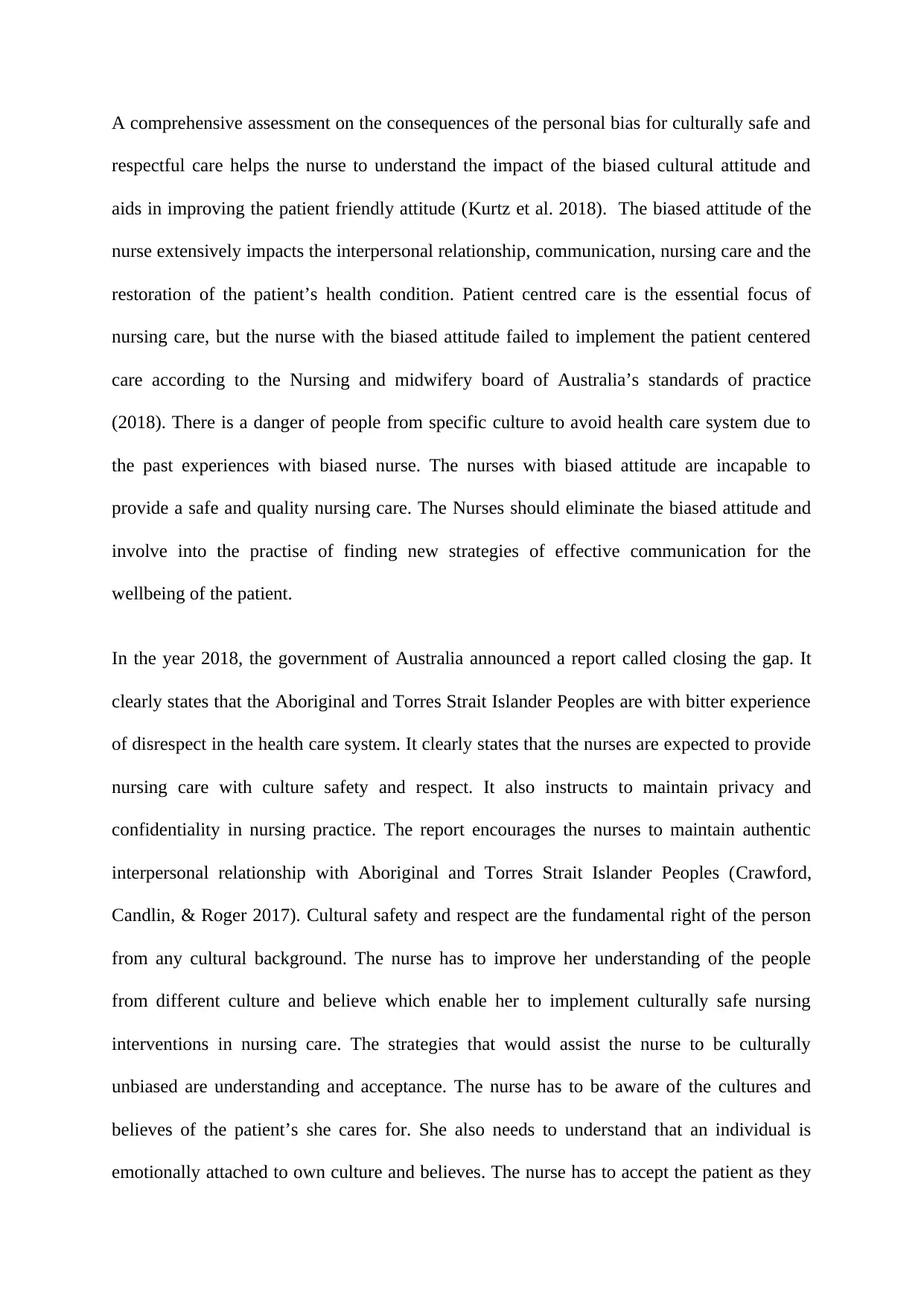
A comprehensive assessment on the consequences of the personal bias for culturally safe and
respectful care helps the nurse to understand the impact of the biased cultural attitude and
aids in improving the patient friendly attitude (Kurtz et al. 2018). The biased attitude of the
nurse extensively impacts the interpersonal relationship, communication, nursing care and the
restoration of the patient’s health condition. Patient centred care is the essential focus of
nursing care, but the nurse with the biased attitude failed to implement the patient centered
care according to the Nursing and midwifery board of Australia’s standards of practice
(2018). There is a danger of people from specific culture to avoid health care system due to
the past experiences with biased nurse. The nurses with biased attitude are incapable to
provide a safe and quality nursing care. The Nurses should eliminate the biased attitude and
involve into the practise of finding new strategies of effective communication for the
wellbeing of the patient.
In the year 2018, the government of Australia announced a report called closing the gap. It
clearly states that the Aboriginal and Torres Strait Islander Peoples are with bitter experience
of disrespect in the health care system. It clearly states that the nurses are expected to provide
nursing care with culture safety and respect. It also instructs to maintain privacy and
confidentiality in nursing practice. The report encourages the nurses to maintain authentic
interpersonal relationship with Aboriginal and Torres Strait Islander Peoples (Crawford,
Candlin, & Roger 2017). Cultural safety and respect are the fundamental right of the person
from any cultural background. The nurse has to improve her understanding of the people
from different culture and believe which enable her to implement culturally safe nursing
interventions in nursing care. The strategies that would assist the nurse to be culturally
unbiased are understanding and acceptance. The nurse has to be aware of the cultures and
believes of the patient’s she cares for. She also needs to understand that an individual is
emotionally attached to own culture and believes. The nurse has to accept the patient as they
respectful care helps the nurse to understand the impact of the biased cultural attitude and
aids in improving the patient friendly attitude (Kurtz et al. 2018). The biased attitude of the
nurse extensively impacts the interpersonal relationship, communication, nursing care and the
restoration of the patient’s health condition. Patient centred care is the essential focus of
nursing care, but the nurse with the biased attitude failed to implement the patient centered
care according to the Nursing and midwifery board of Australia’s standards of practice
(2018). There is a danger of people from specific culture to avoid health care system due to
the past experiences with biased nurse. The nurses with biased attitude are incapable to
provide a safe and quality nursing care. The Nurses should eliminate the biased attitude and
involve into the practise of finding new strategies of effective communication for the
wellbeing of the patient.
In the year 2018, the government of Australia announced a report called closing the gap. It
clearly states that the Aboriginal and Torres Strait Islander Peoples are with bitter experience
of disrespect in the health care system. It clearly states that the nurses are expected to provide
nursing care with culture safety and respect. It also instructs to maintain privacy and
confidentiality in nursing practice. The report encourages the nurses to maintain authentic
interpersonal relationship with Aboriginal and Torres Strait Islander Peoples (Crawford,
Candlin, & Roger 2017). Cultural safety and respect are the fundamental right of the person
from any cultural background. The nurse has to improve her understanding of the people
from different culture and believe which enable her to implement culturally safe nursing
interventions in nursing care. The strategies that would assist the nurse to be culturally
unbiased are understanding and acceptance. The nurse has to be aware of the cultures and
believes of the patient’s she cares for. She also needs to understand that an individual is
emotionally attached to own culture and believes. The nurse has to accept the patient as they
Paraphrase This Document
Need a fresh take? Get an instant paraphrase of this document with our AI Paraphraser
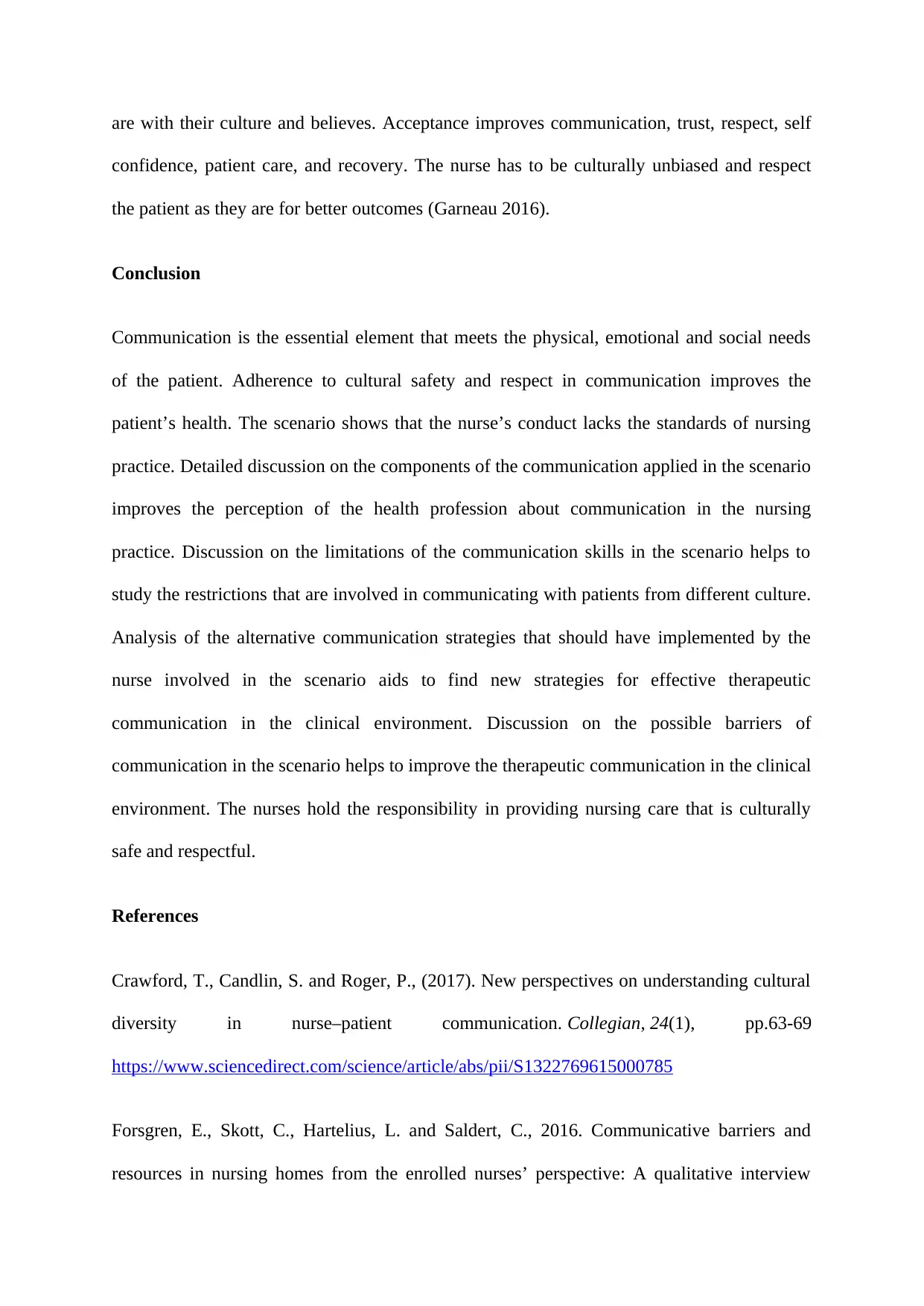
are with their culture and believes. Acceptance improves communication, trust, respect, self
confidence, patient care, and recovery. The nurse has to be culturally unbiased and respect
the patient as they are for better outcomes (Garneau 2016).
Conclusion
Communication is the essential element that meets the physical, emotional and social needs
of the patient. Adherence to cultural safety and respect in communication improves the
patient’s health. The scenario shows that the nurse’s conduct lacks the standards of nursing
practice. Detailed discussion on the components of the communication applied in the scenario
improves the perception of the health profession about communication in the nursing
practice. Discussion on the limitations of the communication skills in the scenario helps to
study the restrictions that are involved in communicating with patients from different culture.
Analysis of the alternative communication strategies that should have implemented by the
nurse involved in the scenario aids to find new strategies for effective therapeutic
communication in the clinical environment. Discussion on the possible barriers of
communication in the scenario helps to improve the therapeutic communication in the clinical
environment. The nurses hold the responsibility in providing nursing care that is culturally
safe and respectful.
References
Crawford, T., Candlin, S. and Roger, P., (2017). New perspectives on understanding cultural
diversity in nurse–patient communication. Collegian, 24(1), pp.63-69
https://www.sciencedirect.com/science/article/abs/pii/S1322769615000785
Forsgren, E., Skott, C., Hartelius, L. and Saldert, C., 2016. Communicative barriers and
resources in nursing homes from the enrolled nurses’ perspective: A qualitative interview
confidence, patient care, and recovery. The nurse has to be culturally unbiased and respect
the patient as they are for better outcomes (Garneau 2016).
Conclusion
Communication is the essential element that meets the physical, emotional and social needs
of the patient. Adherence to cultural safety and respect in communication improves the
patient’s health. The scenario shows that the nurse’s conduct lacks the standards of nursing
practice. Detailed discussion on the components of the communication applied in the scenario
improves the perception of the health profession about communication in the nursing
practice. Discussion on the limitations of the communication skills in the scenario helps to
study the restrictions that are involved in communicating with patients from different culture.
Analysis of the alternative communication strategies that should have implemented by the
nurse involved in the scenario aids to find new strategies for effective therapeutic
communication in the clinical environment. Discussion on the possible barriers of
communication in the scenario helps to improve the therapeutic communication in the clinical
environment. The nurses hold the responsibility in providing nursing care that is culturally
safe and respectful.
References
Crawford, T., Candlin, S. and Roger, P., (2017). New perspectives on understanding cultural
diversity in nurse–patient communication. Collegian, 24(1), pp.63-69
https://www.sciencedirect.com/science/article/abs/pii/S1322769615000785
Forsgren, E., Skott, C., Hartelius, L. and Saldert, C., 2016. Communicative barriers and
resources in nursing homes from the enrolled nurses’ perspective: A qualitative interview
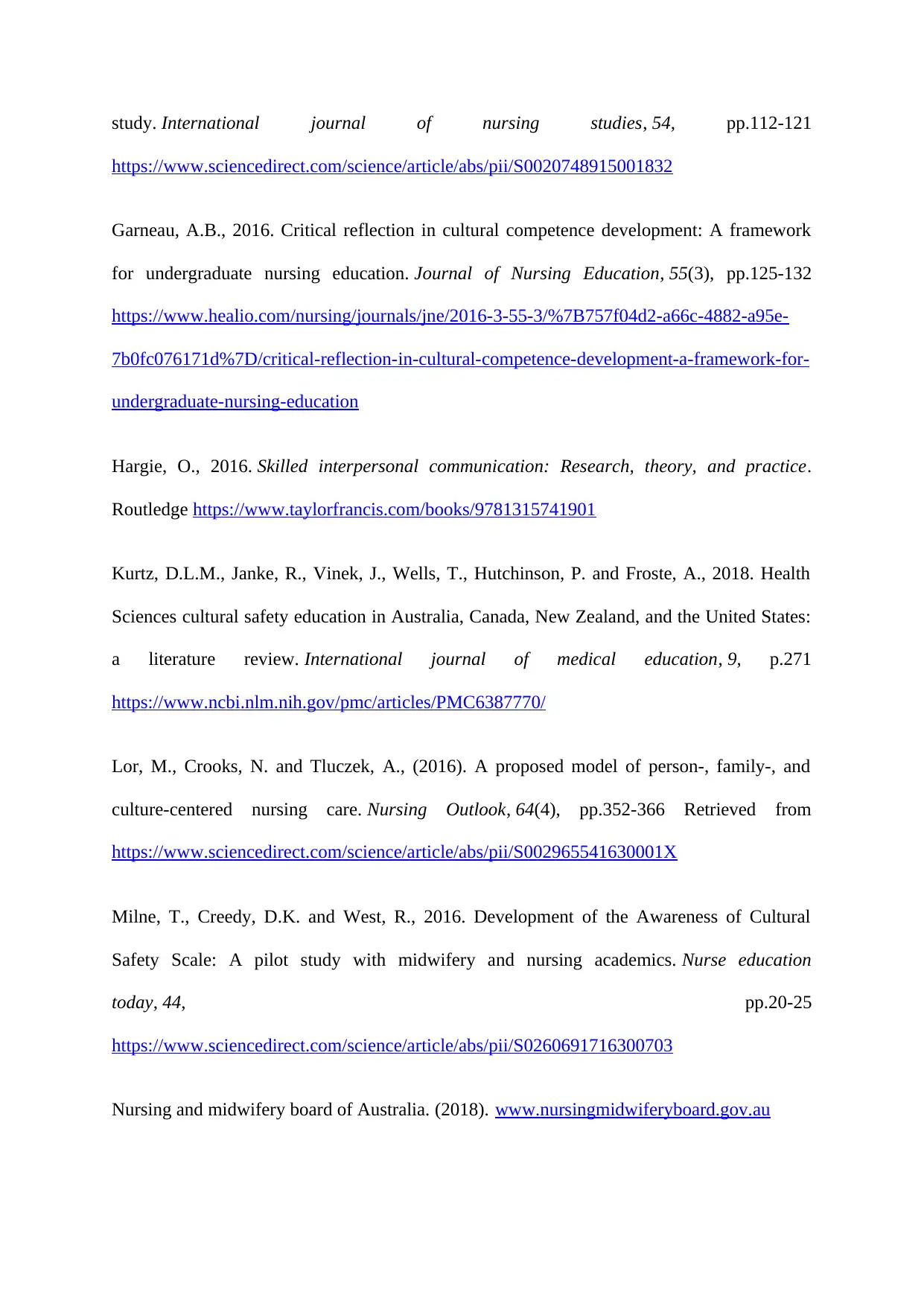
study. International journal of nursing studies, 54, pp.112-121
https://www.sciencedirect.com/science/article/abs/pii/S0020748915001832
Garneau, A.B., 2016. Critical reflection in cultural competence development: A framework
for undergraduate nursing education. Journal of Nursing Education, 55(3), pp.125-132
https://www.healio.com/nursing/journals/jne/2016-3-55-3/%7B757f04d2-a66c-4882-a95e-
7b0fc076171d%7D/critical-reflection-in-cultural-competence-development-a-framework-for-
undergraduate-nursing-education
Hargie, O., 2016. Skilled interpersonal communication: Research, theory, and practice.
Routledge https://www.taylorfrancis.com/books/9781315741901
Kurtz, D.L.M., Janke, R., Vinek, J., Wells, T., Hutchinson, P. and Froste, A., 2018. Health
Sciences cultural safety education in Australia, Canada, New Zealand, and the United States:
a literature review. International journal of medical education, 9, p.271
https://www.ncbi.nlm.nih.gov/pmc/articles/PMC6387770/
Lor, M., Crooks, N. and Tluczek, A., (2016). A proposed model of person-, family-, and
culture-centered nursing care. Nursing Outlook, 64(4), pp.352-366 Retrieved from
https://www.sciencedirect.com/science/article/abs/pii/S002965541630001X
Milne, T., Creedy, D.K. and West, R., 2016. Development of the Awareness of Cultural
Safety Scale: A pilot study with midwifery and nursing academics. Nurse education
today, 44, pp.20-25
https://www.sciencedirect.com/science/article/abs/pii/S0260691716300703
Nursing and midwifery board of Australia. (2018). www.nursingmidwiferyboard.gov.au
https://www.sciencedirect.com/science/article/abs/pii/S0020748915001832
Garneau, A.B., 2016. Critical reflection in cultural competence development: A framework
for undergraduate nursing education. Journal of Nursing Education, 55(3), pp.125-132
https://www.healio.com/nursing/journals/jne/2016-3-55-3/%7B757f04d2-a66c-4882-a95e-
7b0fc076171d%7D/critical-reflection-in-cultural-competence-development-a-framework-for-
undergraduate-nursing-education
Hargie, O., 2016. Skilled interpersonal communication: Research, theory, and practice.
Routledge https://www.taylorfrancis.com/books/9781315741901
Kurtz, D.L.M., Janke, R., Vinek, J., Wells, T., Hutchinson, P. and Froste, A., 2018. Health
Sciences cultural safety education in Australia, Canada, New Zealand, and the United States:
a literature review. International journal of medical education, 9, p.271
https://www.ncbi.nlm.nih.gov/pmc/articles/PMC6387770/
Lor, M., Crooks, N. and Tluczek, A., (2016). A proposed model of person-, family-, and
culture-centered nursing care. Nursing Outlook, 64(4), pp.352-366 Retrieved from
https://www.sciencedirect.com/science/article/abs/pii/S002965541630001X
Milne, T., Creedy, D.K. and West, R., 2016. Development of the Awareness of Cultural
Safety Scale: A pilot study with midwifery and nursing academics. Nurse education
today, 44, pp.20-25
https://www.sciencedirect.com/science/article/abs/pii/S0260691716300703
Nursing and midwifery board of Australia. (2018). www.nursingmidwiferyboard.gov.au
⊘ This is a preview!⊘
Do you want full access?
Subscribe today to unlock all pages.

Trusted by 1+ million students worldwide
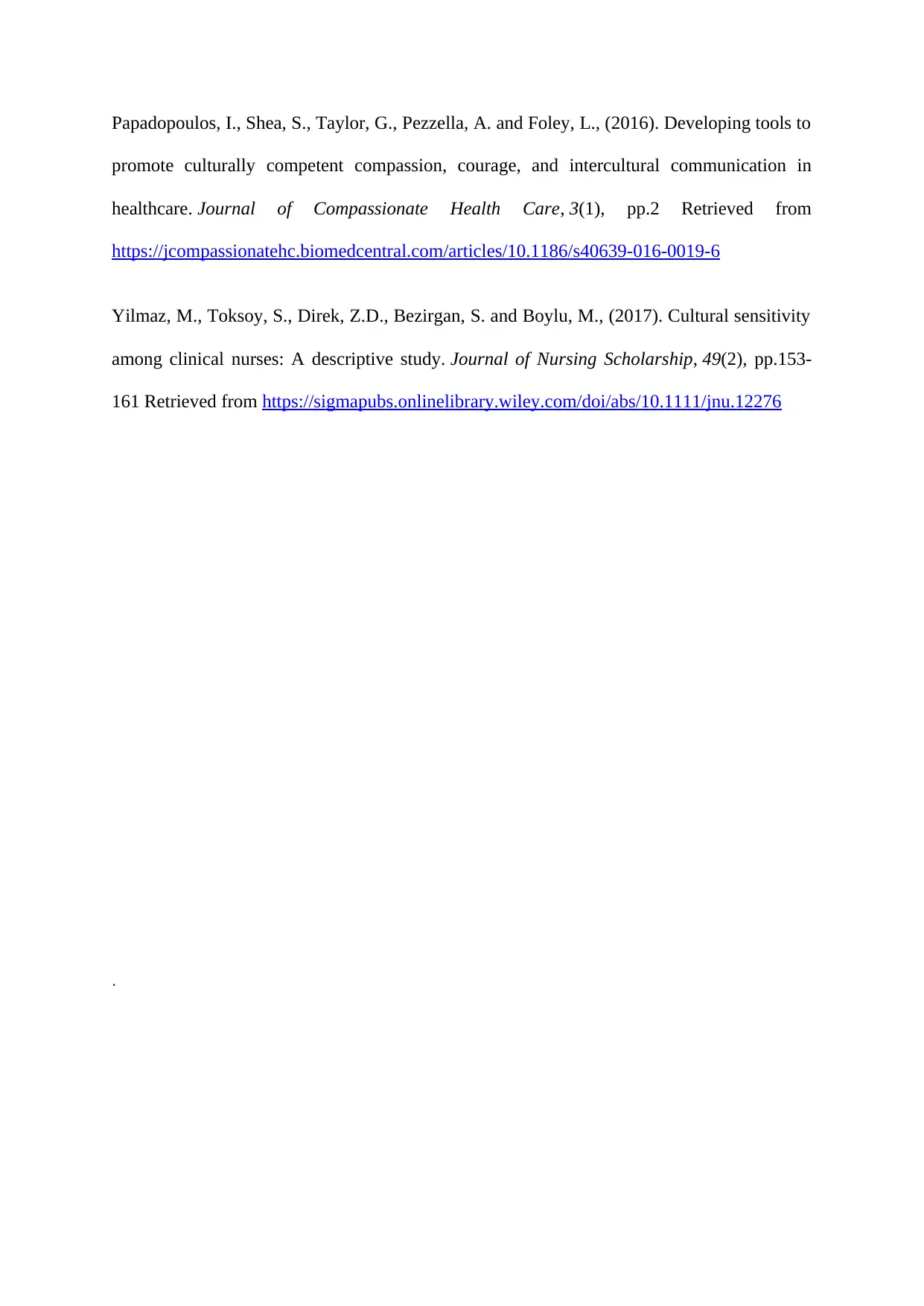
Papadopoulos, I., Shea, S., Taylor, G., Pezzella, A. and Foley, L., (2016). Developing tools to
promote culturally competent compassion, courage, and intercultural communication in
healthcare. Journal of Compassionate Health Care, 3(1), pp.2 Retrieved from
https://jcompassionatehc.biomedcentral.com/articles/10.1186/s40639-016-0019-6
Yilmaz, M., Toksoy, S., Direk, Z.D., Bezirgan, S. and Boylu, M., (2017). Cultural sensitivity
among clinical nurses: A descriptive study. Journal of Nursing Scholarship, 49(2), pp.153-
161 Retrieved from https://sigmapubs.onlinelibrary.wiley.com/doi/abs/10.1111/jnu.12276
.
promote culturally competent compassion, courage, and intercultural communication in
healthcare. Journal of Compassionate Health Care, 3(1), pp.2 Retrieved from
https://jcompassionatehc.biomedcentral.com/articles/10.1186/s40639-016-0019-6
Yilmaz, M., Toksoy, S., Direk, Z.D., Bezirgan, S. and Boylu, M., (2017). Cultural sensitivity
among clinical nurses: A descriptive study. Journal of Nursing Scholarship, 49(2), pp.153-
161 Retrieved from https://sigmapubs.onlinelibrary.wiley.com/doi/abs/10.1111/jnu.12276
.
Paraphrase This Document
Need a fresh take? Get an instant paraphrase of this document with our AI Paraphraser

.
1 out of 8
Related Documents
Your All-in-One AI-Powered Toolkit for Academic Success.
+13062052269
info@desklib.com
Available 24*7 on WhatsApp / Email
![[object Object]](/_next/static/media/star-bottom.7253800d.svg)
Unlock your academic potential
Copyright © 2020–2025 A2Z Services. All Rights Reserved. Developed and managed by ZUCOL.





